Recently we used the Supermicro A1SAi-2550F to look at the platform’s power consumption and performance. Today we are formally reviewing the Supermicro A1SAi-2550F platform itself. For those that have read our A1SAi-2750F or A1SRi-2758F reviews you should have a very good idea regarding this motherboard. All three of these Supermicro motherboards differ in one substantial way: the processor used. The last letter “F” in the part names denote the fact that the boards have IPMI. The other four ending digits “2xxx” refer to the Intel Atom C2xxx processor number. That means that the A1SAi-2550F is a single processor Intel Atom C2550 “Avoton” platform sporting quad cores and Turbo Boost but without Intel Quick Assist found on Rangeley parts.
Test Configurations
We had two main test configurations which is not something we always get to do. Due to the SoC design, the Intel Atom C2550 platform is very compact and requires very little to get up and running. We took this opportunity to validate both Micron and SK Hynix memory working with the Supermicro platforms:
Test Configuration #1 (used for power testing and performance testing):
- Motherboard/ CPU: Supermicro A1SAi-2550F with Intel C2550 Rangeley 4C/ 4T SoC
- SSD: Intel S3700 100GB SSD
- Memory: 16GB (4x 4GB) 1600MHz 1.35v SK Hynix HMT451A7AFR8A and Micron MT18KSF51272HZ-1G6K2ZF DDR3 SODIMMs
- OS: Ubuntu 13.10
- Power supply: 1U 200w 80+ Gold PWS-203-1H
Overall, both memory configurations worked well. We also had additional time with this review so we were able to test add-in cards such as a Mellanox ConnectX-3 VPI Infiniband/ 40GbE card with the motherboard. This is the same set that we utilized with the 8-core platforms so we had a reasonable expectation of success.
The Supermicro A1SAi-2550F
The Supermciro A1SAi-2550F is a compact mini ITX server motherboard. That means it is approximately 6.75″ by 6.75″ and fits in most enclosures, including those that are meant to be SMB sized NAS appliances.
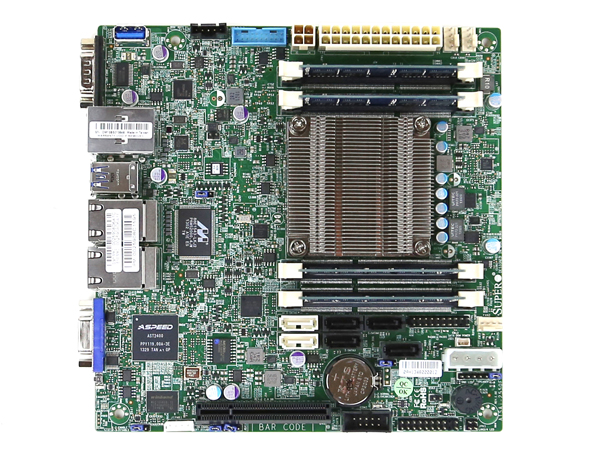
As a slight change, the pictures in this review all include RAM. If you are interested what the motherboard looks like without RAM feel free to look at the A1SAi-2750F or A1SRi-2758F reviews.
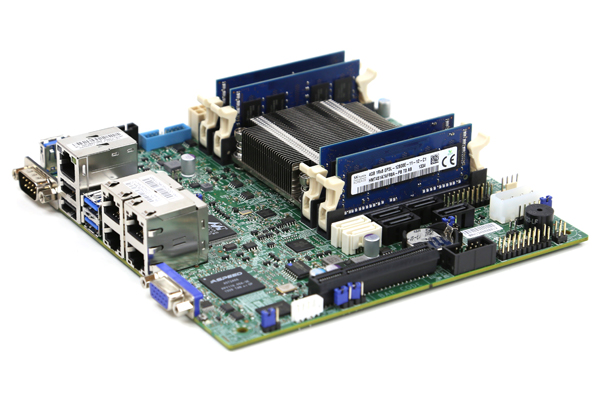
Our A1SRi-2550F came with the standard passive heatsink. Realistically, the Intel Atom C2550 is a 14w maximum TDP SoC. Using the same heatsink used on the 20w 8-core chips means it stays extremely cool given it at most has to dissipate 30% less heat. One does need some nominal airflow but certainly the platform requires only minimal cooling. This is perfect for SMB NAS and network appliances that may be found on or under office desks since it will not require noisy fans to cool.
Using this setup, thermals are excellent even with minimal airflow due to the low TDP of the parts involved.
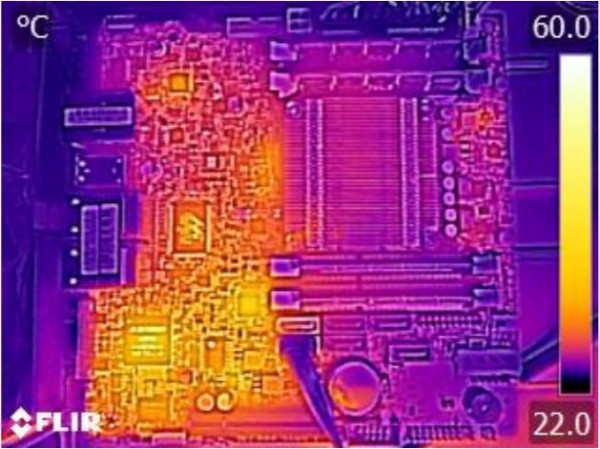
All components are nicely lined up for a front to back cooling environment. Even the 2x SATA III, 4x SATA II and PCIe 2.0 x8 slot are aligned toward this orientation.
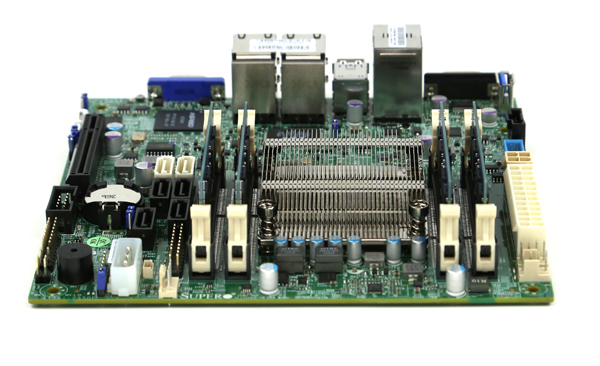
These boards are well thought out in terms of cooling and have room for expansion given the PCIe 2.0 x8 slot to add either an additional RAID controller/ HBA or high-speed network controller.
With the processor and heatsink installed (and the CPU being affixed to the motherboard) this small mITX platform comes pre-installed with virtually everything needed for a working system out of the box. We can again confirm that unbuffered DDR3 ECC SODIMMs worked with the motherboard while standard non-ECC SODIMMs were causing issues. Check manufacturer compatibility lists and use ECC SODIMMs with these server platforms. The price differential between ECC UDIMMs and non-ECC variants is not great enough to justify not using ECC RAM.
The bottom corner of the motherboard shows the only major visually identifiable difference between the A1SAi-2550F pictured here and the A1SAi-2750F.
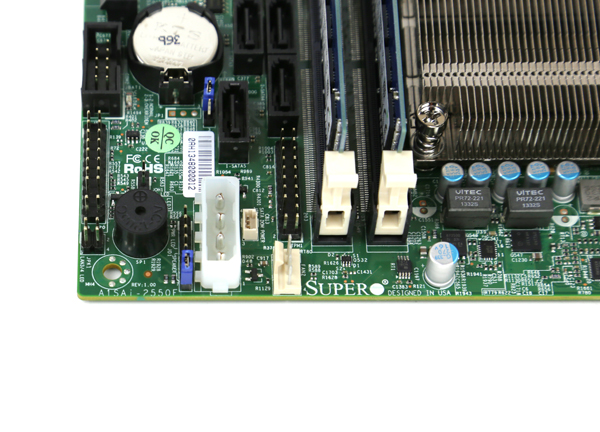
One can see that there is enough room to work between the SODIMMs and SATA slots. Supermicro also supplies a 4-pin Molex easy power connector on the motherboard which is a nice feature for tightly integrated systems.
The top of the motherboard there is a standard 24-pin ATX power connection and a 4-pin CPU power connector. Other very interesting features are both a front panel USB 3.0 connector along with an internal Type-A USB 3.0 header. We have seen users utilize these internal USB 3.0 slots to put boot drives for environments such as VMware ESXi hypervisors and Linux based NAS distributions. Internal USB 3.0 is not a universal feature yet, so this may be an important fact for some users.
Sitting alongside the Intel Atom C2550 SoC are a few key chips. The shot below shows the Marvell Alaska physical interface for the C2550’s Intel i354 quad gigabit network controller. Operating systems see this setup as the Intel i354 so one will utilize Intel Ethernet drivers rather than Marvell drivers. Newer operating system versions are starting to include out-of-box support. Examples of this are CentOS 6.5 and Ubuntu 13.10. Older OS versions will likely require drivers from Intel. Other distributions such as pfsense are working to get drivers to their distribution using a sister platform, the Supermicro A1SRi-2758F as a development platform. The Intel i354 is considered a premium offering above the Intel i210 NIC and is integrated into the Avoton SoC.
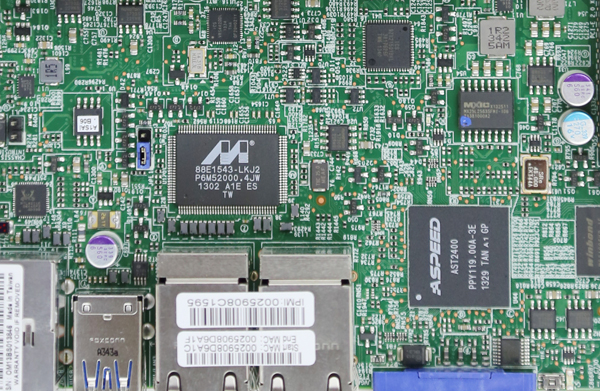
One can see both an ASpeed AST2400 BMC controller (right) and a Realtek NIC (left) on the motherboard behind the rear I/O panel. These chips drive much of the IPMI 2.0 interface functionality. They also provide much of the functionality for out-of-band management of the server.
As for PCIe connectivity the Supermicro A1SAi-2550F has a PCIe 2.0 x8 slot as shown above. This gives the platform a lot of flexibility in terms of being able to add additional controllers. We tested using both 12gbps SAS3 and 6gbps SAS2 LSI HBA and RAID cards and they worked well. We also tested Mellanox ConnectX-2 and ConnectX-3 QDR and FDR Infiniband cards in the slot successfully. Unlike the previous generation Atom S1260, the new Avoton / Rangeley platform is much more robust and having an extra PCIe x8 slot adds much flexibility to the platform. Many users are looking to exploit this capability to build appliances for applications such as cold storage using add-on cards on the Avoton platform.
The rear I/O panel follows the standard Supermicro X9 and X10 series I/O panel design. One can, for example, see a similar layout in our Supermicro X10SL7-F review. There are legacy VGA and serial ports. Peripherals can be connected using two USB 3.0 and two USB 2.0 ports on the rear panel. It may seem like a minor point, but it makes finding replacements much easier.
Networking is provided by a dedicated IPMI port (above the USB stack). The quad Intel i354 Ethernet ports can be found on the rear panel with the bottom left RJ-45 port being the first NIC operating systems recognize. Supermicro utilizes the 1GbE Marvell PHY chip as we saw in earlier board shots.
Software and Management
Supermicro’s IPMI and KVM-over-IP as described a few times on this site, allows for a lot of deployment flexibility. Things such as fan speeds, chassis intrusion sensors, thermal sensors, and etc. can be monitored remotely. Alerts can be setup to notify the admins of issues. Beyond this, the functionality also allows for remote power control. You can do remote power up, power down, and reset of the server in the event that it becomes unresponsive. In fact, the test system has never had a keyboard, mouse, CD/DVD ROM, or monitor hooked up to it, even after multiple BIOS tweaks and operating system/ hypervisor installations.
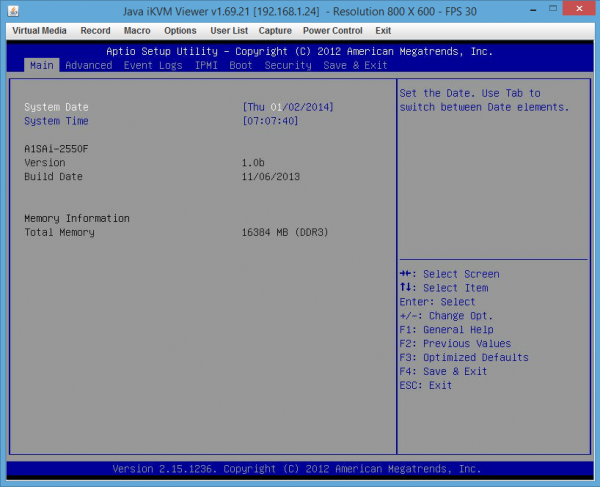
Another important feature is the ability to remotely mount CD images and floppy images to the machine over the dedicated management Ethernet controller. This keeps maintenance traffic off of the primary Intel NICs. It also allows for one to physically segregate the management network from the data network. At the same time it removes the need for an optical disk to be connected to the Supermicro motherboard. Combined with the onboard Type-A USB 3.0 header, mounting OS installation or recovery images remotely is a very simple affair.
Conclusion
As we saw in our performance and power testing, this Supermicro A1SAi-2550F make this a very interesting platform. While the 8 core C2750 and C2758 models are probably better suited for web serving and network appliances, the 4-core model has a lot of potential as a an excellent NAS platform. The Supermicro A1SAi-2550F has enough processing power to run RAID arrays alongside web management for storage systems. With a significantly lower price due to the C2550 costs half of the C2750, and lower power consumption, processor characteristics are better for this market. With quad gigabit Ethernet built-in and a PCIe 2.0 x8 slot, one has a supporting platform that can work well for these types of applications where minimal CPU power is required.






You forgot to mention that the Supermicro A1SAi board (and any other Avoton-based platform from other manufacturers) can be upgraded with 4 modules of 16 Gigabytes each to reach total 64 GB!
It is the first Intel CPU that supports the new 16GB SO-DIMMs (optional with ECC, also available as UDIMMs) from the company I’M Intelligent Memory. Other Intel processors have an architectural limitation to take no bigger modules than 8GB.
Hi (again ;-)) Thorsten,
Do you know when the I’M modules will be available for delivery?
I’ve been looking for them, but still haven’t found them anywhere.
Do you know if there are any issues with using this board as an ESXi 5.5 host? I’m looking for a replacement for my current ESXi host which is an Intel® NUC (D54250WYKH) machine.
I’m happy with the performance of the CPU on the D54250WYKH (an Intel® Core™ i5 4250U processor) but the D54250WYKH only supports 16GB of memory and only has one NIC and I’m finding this a bit limiting.
I’m keen to keep to a low power, small form factor host and this (ot the Supermicro A1SAI-2750F) looks like a good alternative/upgrade to the D54250WYKH if installing ESXi is not a major issue.
Any advice would be appreciated.
Atoms to not have VT-d, only VT-x is available